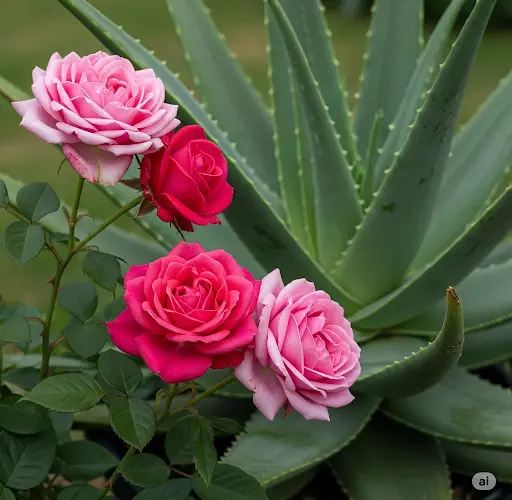Roses are cherished in gardens worldwide for their beauty, fragrance, and symbolism. While growing roses from seeds can be time-consuming and inconsistent, propagating them from cuttings is a faster, more reliable way to reproduce your favorite varieties.
Among various propagation techniques, one natural and surprisingly effective method involves the use of aloe vera. This powerful plant not only promotes root development but also protects cuttings from infection—making it an ideal natural rooting agent. Whether you’re a beginner or a seasoned gardener, this aloe-based method offers a simple, chemical-free way to multiply your rose bushes successfully.
Why Use Aloe Vera for Propagation?
Aloe vera is packed with beneficial compounds that promote root formation and protect plant tissue. It contains:
-
Natural rooting hormones (auxins) that encourage root cell formation
-
Anti-bacterial and anti-fungal properties that reduce the risk of disease in cuttings
-
Amino acids, enzymes, and vitamins that nourish the cutting during the early growth phase
By using aloe vera gel instead of commercial rooting hormones, you create a more natural and environmentally friendly environment for your rose cuttings to thrive.
Materials You’ll Need
-
Healthy rose cuttings (6–8 inches long)
-
Fresh aloe vera leaf (or pure aloe vera gel)
-
Sharp pruning shears or scissors
-
Clean knife or blade
-
Small planting pots or containers
-
Potting mix (well-draining, preferably a mix of soil and perlite or coco peat)
-
Transparent plastic bags or covers (to create a mini greenhouse)
-
Clean water
-
Optional: honey or cinnamon (as additional natural rooting agents)
Step-by-Step Guide
1. Select and Prepare the Rose Cuttings
-
Choose a healthy rose stem that has recently bloomed or is semi-hardwood (not too young, not too woody).
-
Cut a 6–8 inch section using sterilized pruning shears. The cutting should have at least 3–4 nodes (the points where leaves emerge).
-
Remove all flowers and most of the leaves, leaving just one or two at the top to reduce moisture loss through transpiration.
2. Prepare the Aloe Vera
-
Cut a thick aloe vera leaf and slice it open lengthwise to reveal the gel inside.
-
Either dip the base of the rose cutting directly into the fresh gel or extract the gel into a bowl and coat the bottom 2–3 inches of the cutting.
-
If using store-bought aloe vera gel, ensure it is 100% pure with no added chemicals.
3. Optional: Use a Combination of Aloe and Honey or Cinnamon
-
Some gardeners enhance rooting by combining aloe vera with honey or dusting the cutting tip with cinnamon before applying the aloe. Both have antibacterial properties and can further stimulate root growth.
4. Plant the Cutting
-
Fill a small pot or container with well-draining potting mix. Moisten the soil slightly.
-
Use a stick or pencil to make a hole in the soil and insert the cutting (gel-coated end down) about 2–3 inches deep.
-
Press the soil gently around the base to secure the cutting.
5. Create a Mini Greenhouse Environment
-
Cover the pot loosely with a clear plastic bag or container to create a humid microclimate. This reduces moisture loss and encourages rooting.
-
Make sure the plastic doesn’t touch the leaves. You can use small sticks or skewers to support the bag above the cutting.
Care and Maintenance
-
Place the pot in a warm, bright area, but out of direct sunlight.
-
Keep the soil lightly moist but not soggy.
-
Open the plastic cover for a few minutes daily to allow fresh air in and prevent mold.
-
Rooting typically takes 2–4 weeks. You’ll know roots are forming when you see new leaf growth or resistance when gently tugging the stem.
Transplanting
Once the cutting has developed a good root system (after about 4–6 weeks), it can be transplanted into a larger pot or directly into the garden. Choose a location with good sunlight and well-draining soil. Water regularly, but avoid overwatering, especially in the early days after transplanting.
Benefits of This Method
-
Cost-effective: No need for expensive rooting hormones.
-
Natural and safe: Free of synthetic chemicals—safe for children, pets, and pollinators.
-
High success rate: Aloe vera increases the chances of successful root development.
-
Environmentally friendly: Makes use of household plants and garden waste.
Final Thoughts
Propagating roses using aloe vera is a beautiful blend of tradition and science. With minimal effort and no synthetic chemicals, you can multiply your favorite rose bushes and fill your garden with blooms. Whether you want to expand your rose collection or gift a cutting to a fellow gardener, this natural method is simple, effective, and rewarding.
Give it a try—and let your garden flourish with new life grown straight from nature’s own rooting tonic.



